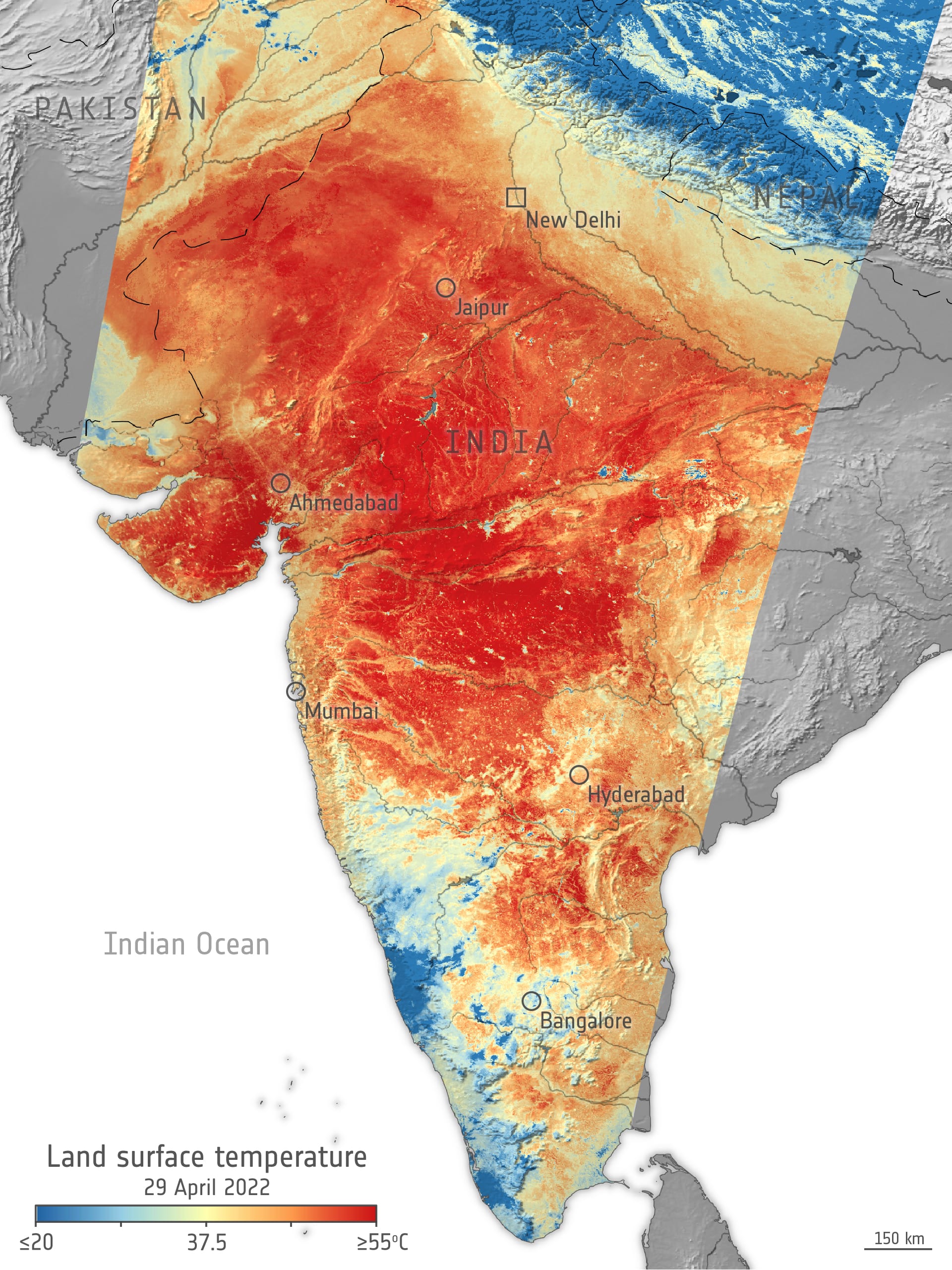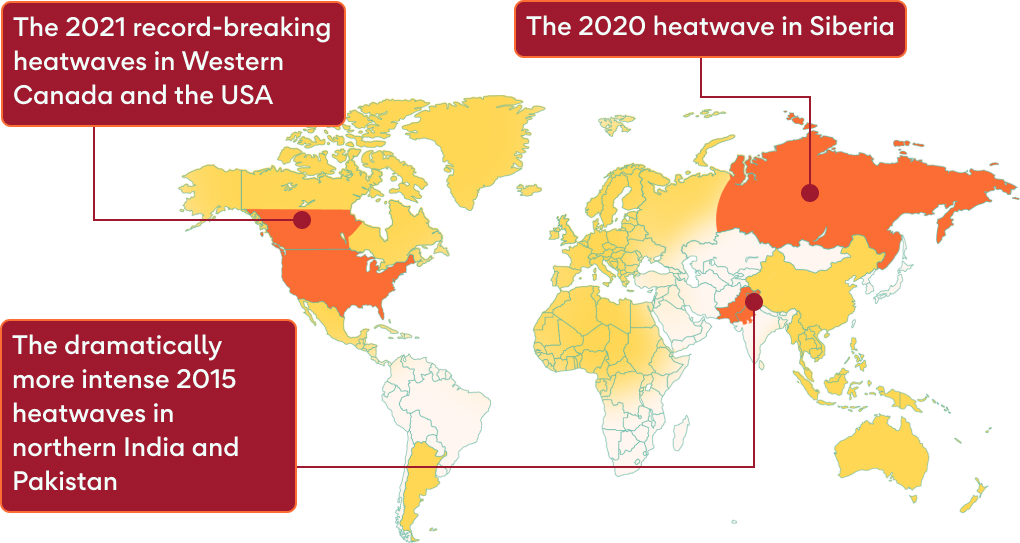Heatwaves in India
Clear indicators of a rapidly warming planet
Hotter days and heatwaves have ravaged much of the world in 2022. As the planet gets hotter, these extreme phenomena are not likely to ease up. Reducing greenhouse gas emissions is still an important step, but governments need to step up national adaptation strategies, which will save countless lives as the world gets warmer.
Heatwaves are defined as an extended period of unusually hot weather. Over the years, there have been more heatwaves across the globe.
In 2022, they were particularly persistent across most parts of the world, and nowhere on Earth is this trend more obvious than in India.
From mid-March to late April, heatwaves permeated 16 out of 28 states in the country.

In particular, on 26 April, the Bhalswa landfill in Delhi was ignited by the heat, and was in flames for two weeks. It is an overfilled landfill collected from around half of Delhi’s population, which amounts to around 16 million people.
Already a major source of environmental pollution and a major public health hazard, the fires further endangered the thousands of people living in slums at the mountain base and stunted eventual rescue efforts.
Heatwaves aren’t an abnormal phenomenon. For India, they regularly happen right before a monsoon.
However, it is undeniable that the frequency and intensity of heatwaves are getting worse over time.
In 2022, India reached high temperatures earlier than expected. During the same period of time, the country experienced overall less rainfall than usual, which meant extreme heat and dryness gripped the population, affecting overall public health and livelihoods across the Northwest region.
By the end of April, 70% of the population was affected. This intense heat continued for months, stretching to the coasts and east India, and became unbearable for most living beings—for every day the temperature rises above 35°C in India, the annual mortality rate goes up by 0.75%.
Even resilient, urban dwelling wildlife aren’t spared. When temperatures in Delhi hit 49.4°C one day in May, the extreme temperature caused birds to fall directly out of the sky.
According to the World Weather Attribution, human-induced climate change made the heatwaves that swept over India in 2022 about 30 times more likely to occur.
Before the Industrial Revolution, it was found that these heatwaves would have been a whole 1°C cooler.
Research has also shown that without climate change, these events would not have occurred:

The same can be said about the heatwaves in China, Argentina, most of Europe and North America, North and Central Africa, Australasia, and Southeast Asia. Without climate change, these heatwaves would either not have happened, or would have been much less intense.
India is doing their best to adapt. In 2010, the municipal government of Ahmedabad initiated an action plan in response to the heatwaves, which involved:
An awareness campaign
Early-warning procedures
Higher capacity within the healthcare system
More trained medical professionals who can quickly recognise heat stress
More drinking water supplies in temples, parks, and other public spaces
Similar measures have been implemented in Delhi and other cities, and these plans save around 1,200 lives every year.
Other solutions, including technical ones such as installing cooling roofs in slums and misting systems in underground railways, as well as measures to improve overall air quality, have been suggested and/or implemented.
But global temperatures continue to rise.
Between 2000 to 2016, around 125 million more people were exposed to heatwaves. In the future, even more people will suffer from hotter days, and it will affect their livelihoods and health adversely.
When temperatures reach 2°C above pre-industrial era, the heatwaves we now face will increase in likelihood by 2 to 20 times, and will get even hotter by 0.5 to 1.5°C.
This means that while it is still extremely crucial to reduce greenhouse gas emissions and slow down global warming, countries must now also focus on adaptation strategies, to prepare for future extreme temperatures.
This story was first published on Kontinentalist’s Instagram on September 23, 2022. The original version was written by Gwyneth Cheng and illustrated by Griselda Gabriele.
Data for this story was mainly obtained from secondary online sources. All sources are listed below the data visualisations and in the references list.
References
Dasgupta, Debarshi. “India’s huge landfills go up in flames amid record-breaking temperatures.”The Straits Times. May 8, 2022.https://www.straitstimes.com/asia/south-asia/indias-huge-landfills-go-up-in-flames-amid-record-breaking-temperatures.
Khullar, Dhruv. “Living through India’s next-level heat wave.” The New Yorker, July 25, 2022.https://www.newyorker.com/magazine/2022/08/01/living-through-indias-next-level-heat-wave.
Pandey, Kiran. “State of India’s environment in figures: India recorded 280 heat wave days across 16 states in 2022—Most in decade.” Down To Earth, June 2, 2022.https://www.downtoearth.org.in/news/climate-change/state-of-india-s-environment-in-figures-india-recorded-280-heat-wave-days-across-16-states-in-2022-most-in-decade-83131.
Rosane, Olivia. “Deadly heat wave in India and Pakistan was 30x more likely due to climate change, scientists say.” World Economic Forum, June 7, 2022.https://www.weforum.org/agenda/2022/06/deadly-heat-wave-in-india-and-pakistan-was-30x-more-likely-due-to-climate-change-scientists-say/.
World Health Organization. “Heatwaves,” n.d.https://www.who.int/health-topics/heatwaves.
World Weather Attribution. “Climate change made devastating early heat in India and Pakistan 30 times more likely,” May 23, 2022.https://www.worldweatherattribution.org/climate-change-made-devastating-early-heat-in-india-and-pakistan-30-times-more-likely/.